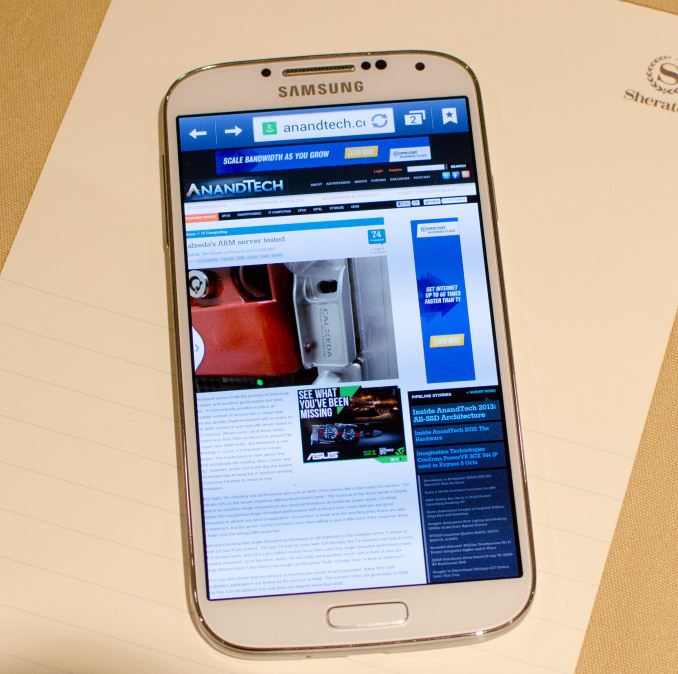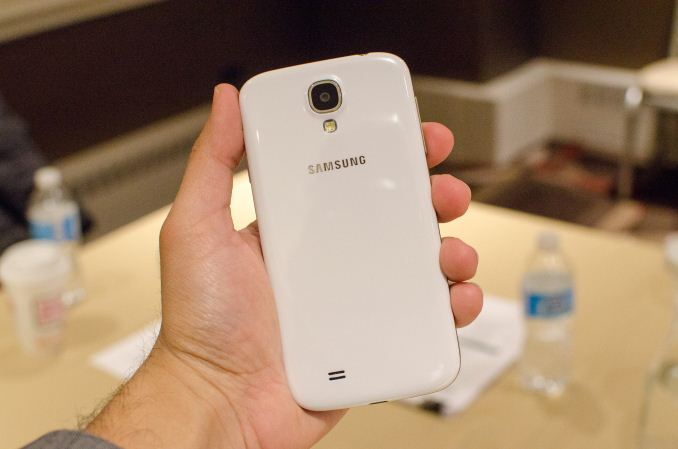Samsung's Galaxy S 4: Introduction & Hands On
by Anand Lal Shimpi on March 14, 2013 7:30 PM EST- Posted in
- Smartphones
- Samsung
- Mobile
- Galaxy S 4
Final Words
With a release scheduled for sometime in Q2 of this year, today’s announcement is more of a preview. We’re sure to have more details on hardware and software in the coming months. For now, the Galaxy S 4 seems like a logical evolution of the Galaxy S lineup. Faster hardware and a larger higher-resolution display were both expected and delivered upon.
Power users will be pleased by the modern SoC integration, and I’m sure there are some that will still be happy with the removable battery and micro SD card slot.
Samsung has continued to increase its focus on delivering enhancements through software, which is very obvious based on the list of launch features for the Galaxy S 4. Although I’m sure power users will still prefer unmodified Android, it’s important to note that many of the features Samsung is introducing with the Galaxy S 4 will be very easy to market to mainstream consumers. The ability to control your smartphone without ever touching it or pause/unpause video with a glance are marketing messages that are very clear and easy to deliver.
The same is true for the enhancements to the camera app. While Samsung continued down the path of the megapixel race, truth be told it will have an easier time selling the Galaxy S 4 to mainstream consumers based on specs and the added features enabled by the new camera app.
Round it all up with S Translate and S Health, two more features that aren’t really new but definitely speak directly to consumers. It’s Apple’s Siri strategy, but coming from many different angles. Samsung’s consumer focused strategy is one that has done very well and I see the Galaxy S 4 continuing that. The real question is how well all of these features will perform/work in final software. Conceptually the Galaxy S 4’s software suite makes a lot of sense, the proof as always will be in the execution and how long it takes Samsung to get to the appropriate level of polish.












206 Comments
View All Comments
tommydaniel - Thursday, March 14, 2013 - link
The S3 does have a stripe around it that is made to look somewhat metal-ish but is indeed plastic..CeriseCogburn - Saturday, March 16, 2013 - link
The iPhone4 is a lead weight - if belongs in an auto mechanics tool chest, not as a portable phone, and it's tiny screen is a health hazard.That's "quality" to our retard drooling monkeys, though.
Then they drop it, it shatters front or back or both, and they say " Damn! that really felt good, it's a high quality build !"
RETARDS.
RETARDED.
RETARDS
RETARDED
CeriseCogburn - Saturday, March 16, 2013 - link
You and all the appl wouldabee fanboys need to feel good when they rub their phone, it's their only companionship after all. The only hardware they will ever be holding in their hands.How it feels matters because they can't use it, they just drool on it while they stare at it's "feel", then they buy a cover anyway.
It's how retards function, which is too say, they are tamponic.
kpb321 - Thursday, March 14, 2013 - link
Interesting. If the A15 cores are only clocked at 1.2ghz max the Qualcom quad core will probably offer higher max performance. The Exynos 5 Octa may offer better battery life if it can spend most of its time using the A7 cores especially at lower clocks. I'd bet the US will get the Qualcom processor as that has been the trend lately.Aenean144 - Thursday, March 14, 2013 - link
Yeah. A 1.2 GHz Cortex-A15 doesn't sound all that competitive to a 1.5 GHz Krait or Swift, and it appears 2013 Kraits will be in the 1.6 to 1.9 GHz range. If 1.2 GHz is truly the max, either Samsung has put something extra in the Cortex-A15 to make competitive or they are going to be crushed by Kraits shipping at about 50% more clock frequency.sleepeeg3 - Thursday, March 14, 2013 - link
Clock frequency is a meaningless comparison between different architectures. I can't believe that's still being brought up on this site, of all places.Aenean144 - Friday, March 15, 2013 - link
It's not meaningless if you have a sense of the performance per cycle for the different architectures.Krait is about 3.3 DMIPS/MHz. A15 is about 3.5 DMIPS/MHz. Cortex-A9 is about 2.5 DMIPS/MHz. Cortex-A7 is about 1.9 DMIPS/MHz. Work it out from there. I got this info from this site.
lmcd - Friday, March 15, 2013 - link
3.3 was an exaggeration, 3.5 an underestimate. See the A15 versus S4 Pro with the Nexus 10 v 4.Krysto - Friday, March 15, 2013 - link
Did you see any of the benchmarks for A15 yet? It gets much higher scores than than 7% more that those "official" DMIPS would let you believe. Why do you think Samsung underlocked the A15's to 1.6 Ghz? They didn't want the international version to be much faster.Aenean144 - Friday, March 15, 2013 - link
Ok, are the A15 cores in the SG4 clocked at 1.6 GHz or 1.2 GHz? Anand is saying 1.2 GHz as of the original publishing of the article.Of course the DMIPS could be off by a bit, it's saying the Cortex-A15 is about 5 to 15% faster. Will it be off by 50% if the A15s are only clocked 1.2 GHz? Seems like a whole lot of performance to make up. I'm sure there are specific ops on an A15 that outperform a +50% clocked Krait, but on average? I'm kind of doubting it right. Wait and see.